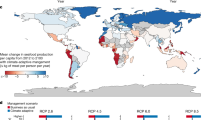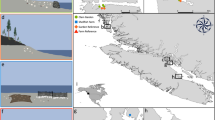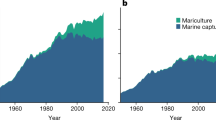Abstract
Mariculture is one of the fastest growing global markets. Although it has potential to improve livelihoods and facilitate economic growth, it can negatively impact marine biodiversity. Here we estimate local cumulative environmental impacts from current and future (2050) mariculture production on marine biodiversity (20,013 marine fauna), while accounting for species range shifts under climate change. With strategic planning, the 1.82-fold increase in finfish and 2.36-fold increase in bivalve production needed to meet expected global mariculture demand in 2050 could be achieved with up to a 30.5% decrease in cumulative impact to global marine biodiversity. This is because all future mariculture farms are strategically placed in sea areas with the lowest cumulative impact. Our results reveal where and how much mariculture impacts could change in the coming decades and identify pathways for countries to minimize risks under expansion of mariculture and climate change through strategic planning.
This is a preview of subscription content, access via your institution
Access options
Access Nature and 54 other Nature Portfolio journals
Get Nature+, our best-value online-access subscription
27,99 € / 30 days
cancel any time
Subscribe to this journal
Receive 12 digital issues and online access to articles
118,99 € per year
only 9,92 € per issue
Buy this article
- Purchase on SpringerLink
- Instant access to full article PDF
Prices may be subject to local taxes which are calculated during checkout





Similar content being viewed by others
Data availability
Data on the distribution of current mariculture farms were obtained from ref. 24. Data on the distribution of potential mariculture areas in 2050 were obtained from ref. 6. Data on the current and future distributions of marine species were obtained from AquaMaps23. Species vulnerability data were obtained from ref. 22. Source data are provided with this paper.
Code availability
The code used to conduct the analysis are archived via Figshare at https://doi.org/10.6084/m9.figshare.27132759 (ref. 58).
References
Larsen, R., Eilertsen, K.-E. & Elvevoll, E. O. Health benefits of marine foods and ingredients. Biotechnol. Adv. 29, 508–518 (2011).
The State of World Fisheries and Aquaculture 2022 (FAO Fisheries and Aquaculture Department, 2022).
Naylor, R. L. et al. A 20-year retrospective review of global aquaculture. Nature 591, 551–563 (2021).
Fisheries and Aquaculture Statistics. Global Aquaculture and Fisheries Production 1950–2018 (FAO Fisheries and Aquaculture Department, 2020).
Costello, C. et al. The future of food from the sea. Nature 588, 95–100 (2020).
Free, C. M. et al. Expanding ocean food production under climate change. Nature 605, 490–496 (2022).
Henriksson, P. J. G. et al. Interventions for improving the productivity and environmental performance of global aquaculture for future food security. One Earth 4, 1220–1232 (2021).
Gentry, R. R. et al. Mapping the global potential for marine aquaculture. Nat. Ecol. Evol. 1, 1317–1324 (2017).
Primavera, J. H. Overcoming the impacts of aquaculture on the coastal zone. Ocean Coastal Manage. 49, 531–545 (2006).
Barrett, L. T., Swearer, S. E. & Dempster, T. Impacts of marine and freshwater aquaculture on wildlife: a global meta-analysis. Rev. Aquacult. 11, 1022–1044 (2019).
Marbà, N., Santiago, R., Díaz-Almela, E., Álvarez, E. & Duarte, C. M. Seagrass (Posidonia oceanica) vertical growth as an early indicator of fish farm-derived stress. Estuarine Coastal Shelf Sci. 67, 475–483 (2006).
Goldberg, L., Lagomasino, D., Thomas, N. & Fatoyinbo, T. Global declines in human‐driven mangrove loss. Global Change Biol. 26, 5844–5855 (2020).
Malone, T. C. & Newton, A. The globalization of cultural eutrophication in the coastal ocean: causes and consequences. Front. Mar. Sci. 7, 670 (2020).
San Diego-McGlone, M. L., Azanza, R. V., Villanoy, C. L. & Jacinto, G. S. Eutrophic waters, algal bloom and fish kill in fish farming areas in Bolinao, Pangasinan, Philippines. Mar. Pollut. Bull. 57, 295–301 (2008).
van der Schatte Olivier, A. et al. A global review of the ecosystem services provided by bivalve aquaculture. Rev. Aquacult. 12, 3–25 (2020).
Pinsky, M. L., Worm, B., Fogarty, M. J., Sarmiento, J. L. & Levin, S. A. Marine taxa track local climate velocities. Science 341, 1239–1242 (2013).
Poloczanska, E. S. et al. Global imprint of climate change on marine life. Nat. Clim. Change 3, 919–925 (2013).
The United Nations Decade of Ocean Science for Sustainable Development (2021–2030) Implementation Plan (UNESCO-IOC, 2021).
Transforming Our World: The 2030 Agenda for Sustainable Development (UN, 2015).
Gephart, J. A. et al. Environmental performance of blue foods. Nature 597, 360–365 (2021).
McIntosh, P. et al. Supersizing salmon farms in the coastal zone: a global analysis of changes in farm technology and ___location from 2005 to 2020. Aquaculture 553, 738046 (2022).
Butt, N. et al. A trait-based framework for assessing the vulnerability of marine species to human impacts. Ecosphere 13, e3919 (2022).
Kaschner, K. et al. AquaMaps: Predicted range maps for aquatic species; retrieved from https://www.aquamaps.org(2019).
Clawson, G. et al. Mapping the spatial distribution of global mariculture production. Aquaculture 553, 738066 (2022).
Kautsky, N., Rönnbäck, P., Tedengren, M. & Troell, M. Ecosystem perspectives on management of disease in shrimp pond farming. Aquaculture 191, 145–161 (2000).
Ramesh, R. et al. In Wetland Science: Perspectives from South Asia (eds Prusty, B. A. K. et al.) 515–544 (Springer, 2017).
Muñoz, J. M. B. Progress of coastal management in Latin America and the Caribbean. Ocean Coastal Manage. 184, 105009 (2020).
Yang, S. et al. The transformation of 40-year coastal wetland policies in China: network analysis and text analysis. Environ. Sci. Technol. 56, 15251–15260 (2022).
Slobodian, L. et al. Mangrove Law and Policy: Legal and Policy Frameworks that Enable Mangrove Conservation, Restoration and Sustainable Use, in Support of Global Goals for Climate, Biodiversity and Sustainable Development (Global Mangrove Alliance, 2023).
Fang, Q., Ma, D., Zhang, L. & Zhu, S. Marine functional zoning: a practical approach for integrated coastal management (ICM) in Xiamen. Ocean Coastal Manage. 207, 104433 (2021).
Teng, X. et al. Implementing marine functional zoning in China. Mar. Policy 132, 103484 (2021).
Ehler, C. N. Two decades of progress in marine spatial planning. Mar. Policy 132, 104134 (2021).
Friess, B. & Grémaud-Colombier, M. Policy outlook: recent evolutions of maritime spatial planning in the European Union. Mar. Policy 132, 103428 (2021).
MSPglobal: International Guide on Marine/maritime Spatial Planning (eds Iglesias Campos, A. et al.) (IOC/UNESCO, DG-MARE, 2021).
Brugere, C., Bansal, T., Kruijssen, F. & Williams, M. Humanizing aquaculture development: putting social and human concerns at the center of future aquaculture development. J. World Aquacult. Soc. 54, 482–526 (2023).
Asche, F., Bjørndal, T. & Young, J. A. Market interactions for aquaculture products. Aquacult. Econ. Manage. 5, 303–318 (2001).
Eagle, J., Naylor, R. & Smith, W. Why farm salmon outcompete fishery salmon. Mar. Policy 28, 259–270 (2004).
Mansfield, E. J. et al. Anticipating trade-offs and promoting synergies between small-scale fisheries and aquaculture to improve social, economic, and ecological outcomes. npj Ocean Sustain. 3, 1–11 (2024).
Yu, J. & Yin, W. Exploring stakeholder engagement in mariculture development: challenges and prospects for China. Mar. Policy 103, 84–90 (2019).
Fishery and Aquaculture Statistics—Yearbook 2020 report no. 2070-6057 (FAO, 2023).
Skirtun, M. et al. Plastic pollution pathways from marine aquaculture practices and potential solutions for the North-East Atlantic region. Mar. Pollut. Bull. 174, 113178 (2022).
Findlay, C. et al. Mapping widespread and increasing underwater noise pollution from acoustic deterrent devices. Mar. Pollut. Bull. 135, 1042–1050 (2018).
McConnell, A., Routledge, R. & Connors, B. Effect of artificial light on marine invertebrate and fish abundance in an area of salmon farming. Mar. Ecol. Prog. Ser. 419, 147–156 (2010).
Bath, G. E., Price, C. A., Riley, K. L. & Morris, J. A. Jr A global review of protected species interactions with marine aquaculture. Rev. Aquacult. 15, 1686–1719 (2023).
Maxwell, S. M. et al. Cumulative human impacts on marine predators. Nat. Commun. 4, 2688 (2013).
O’Hara, C. C., Frazier, M. & Halpern, B. S. At-risk marine biodiversity faces extensive, expanding, and intensifying human impacts. Science 372, 84–87 (2021).
Halpern, B. S. et al. A global map of human impact on marine ecosystems. Science 319, 948–952 (2008).
Weitzman, J., Steeves, L., Bradford, J. & Filgueira, R. In World Seas: An Environmental Evaluation, Second Edition (ed. Sheppard, C.) 197–220 (Academic Press, 2019).
Tan, K. et al. Effects of bivalve aquaculture on plankton and benthic community. Sci. Total Environ. 914, 169892 (2024).
Weber, M. M., Stevens, R. D., Diniz-Filho, J. A. F. & Grelle, C. E. V. Is there a correlation between abundance and environmental suitability derived from ecological niche modelling? A meta-analysis. Ecography 40, 817–828 (2017).
Sardain, A., Sardain, E. & Leung, B. Global forecasts of shipping traffic and biological invasions to 2050. Nat. Sustainability 2, 274–282 (2019).
Bugnot, A. et al. Current and projected global extent of marine built structures. Nat. Sustainability 4, 33–41 (2021).
Grall, J. & Chauvaud, L. Marine eutrophication and benthos: the need for new approaches and concepts. Global Change Biol. 8, 813–830 (2002).
Diaz, R. J. & Rosenberg, R. Spreading dead zones and consequences for marine ecosystems. Science 321, 926–929 (2008).
Klein, C. J. et al. Shortfalls in the global protected area network at representing marine biodiversity. Sci. Rep. 5, 17539 (2015).
Brito-Morales, I. et al. Climate velocity reveals increasing exposure of deep-ocean biodiversity to future warming. Nat. Clim. Change 10, 576–581 (2020).
Hodapp, D. et al. Climate change disrupts core habitats of marine species. Global Change Biol. 29, 3304–3317 (2023).
Ma, D. The code for calculating mariculture impacts on marine biodiversity. Figshare https://doi.org/10.6084/m9.figshare.27132759 (2024).
Acknowledgements
We thank J. A. Gephart for providing raw data on greenhouse gas, nitrogen and phosphorus emissions per farm. We also thank J. Ruesink for providing comments on mariculture pressures. We acknowledge financial support from University of Michigan’s School for Environment and Sustainability and Institute for Global Change Biology. B.S.H. and M.F. were supported by funding from the National Science Foundation (Federal Award Number (FAIN) 2019902). J.G.M was supported by funding from the Japan Science and Technology Agency (JST SICORP grant JPMJSC20E5).
Author information
Authors and Affiliations
Contributions
D.M., B.S.H. and N.H.C. conceived this study. D.M., B.S.H., C.M.F., J.G.M., M.F. designed the methods, with input from B.A., J.A., B.C.W. and N.H.C. D.M. collected data, performed the analysis and drafted the initial manuscript. D.M., B.S.H., B.A., J.A., J.G.M., C.M.F., B.C.W., M.F., K.K. and N.H.C. edited the manuscript. N.H.C., B.A., J.A. and B.C.W. acquired the funding.
Corresponding author
Ethics declarations
Competing interests
The authors declare no competing interests.
Peer review
Peer review information
Nature Ecology & Evolution thanks the anonymous reviewer(s) for their contribution to the peer review of this work.
Additional information
Publisher’s note Springer Nature remains neutral with regard to jurisdictional claims in published maps and institutional affiliations.
Extended data
Extended Data Fig. 1 Distribution of changes in CIM between the best-case and worst-case scenarios and each randomized mariculture scenario.
(a and b): RCP 8.5 scenario; (c and d): RCP 4.5 scenario.
Extended Data Fig. 2 Global distribution of CIM in 2050 under the best-case and worst-case scenarios under RCP 4.5.
(a) best-case scenario estimated at the global scale, (b) worst-case scenario estimated at the global scale, (c) best-case scenario estimated at the country level, (d) worst-case scenario estimated at the country level. The distribution of CIM was divided into five categories using quintiles.
Extended Data Fig. 3 Global distribution of CIM per unit farm across all potential mariculture areas in 2050 under RCP 8.5.
(a) general marine fish. (b) Salmonidae fish. (c) bivalve. The distribution of CIM per unit farm was divided into five categories using quintiles.
Extended Data Fig. 4 Global distribution of CIM per unit farm across all potential mariculture areas in 2050 under RCP 4.5.
(a) general marine fish. (b) Salmonidae fish. (c) bivalve. The distribution of CIM per unit farm was divided into five categories using quintiles.
Supplementary information
Supplementary Information
Supplementary results under RCP 4.5 climate scenario, results of sensitivity analyses, Supplementary Figs. 1–10 and Supplementary Tables 1–10.
Source data
Source Data Fig. 5
Statistical source data.
Source Data Extended Data Fig. 1
Statistical source data.
Rights and permissions
Springer Nature or its licensor (e.g. a society or other partner) holds exclusive rights to this article under a publishing agreement with the author(s) or other rightsholder(s); author self-archiving of the accepted manuscript version of this article is solely governed by the terms of such publishing agreement and applicable law.
About this article
Cite this article
Ma, D., Halpern, B.S., Abrahms, B. et al. Strategic planning could reduce farm-scale mariculture impacts on marine biodiversity while expanding seafood production. Nat Ecol Evol 9, 565–575 (2025). https://doi.org/10.1038/s41559-025-02650-6
Received:
Accepted:
Published:
Issue Date:
DOI: https://doi.org/10.1038/s41559-025-02650-6
This article is cited by
-
Seafood for thought
Nature Ecology & Evolution (2025)



